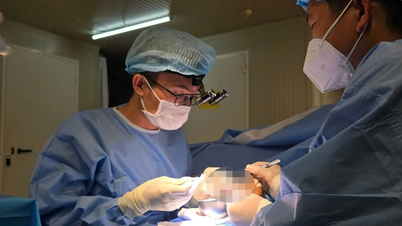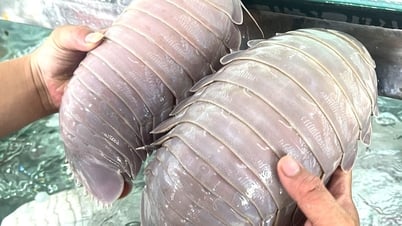The first fetal catheterization was unsuccessful, so the medical team from Tu Du Hospital and Children's Hospital 1 stopped and continued the second catheterization after a week - Photo: Provided by Tu Du Hospital
The catheterization of a 25-week-old fetus (weighing 600 grams) for a Singaporean pregnant woman is the most difficult case among the 9 fetal heart intervention cases at Tu Du Hospital (HCMC) so far.
This is a major milestone in professional techniques, marking a new turning point in fetal medicine in Vietnam. This not only treats patients domestically, but also becomes a destination for foreign patients.
Accept to stop the first fetal heart catheterization to have the next chance
After more than 10 hours of successful fetal catheterization for a Singaporean pregnant woman, speaking with Tuoi Tre Online on the evening of May 28, Dr. Tran Ngoc Hai - Director of Tu Du Hospital - said that this case of fetal catheterization was "an extremely complicated and difficult consideration" when deciding to stop the first fetal catheterization.
Under the direction of Director of Health Department Tang Chi Thuong and the highest determination of the team, new plans were established for the second fetal catheterization and the results were successful.
As a key member of the fetal catheterization team for the Singaporean pregnant woman, Dr. Do Nguyen Tin - head of the cardiovascular intervention unit at Children's Hospital 1 - confided that the moment the fetal catheterization was successful, the whole family, the pregnant woman and the team burst into tears, overwhelmed with emotion.
According to Dr. Tin, because the pregnant woman was a foreigner, the entire process of fetal catheterization was more stressful than previous cases. Not only that, the disease progressed severely, making it difficult to catheterize. Because the first catheterization failed, the second catheterization was more stressful.
"The important thing is to accept stopping the first time, so I have a chance to do it a second time," Dr. Tin shared.
Director of Ho Chi Minh City Department of Health Tang Chi Thuong (left), Director of Tu Du Hospital (middle) and Dr. Do Nguyen Tin - Children's Hospital 1 - Photo: Provided by Tu Du Hospital
Breathtaking developments, unexpected results
Previously, the woman became pregnant through in vitro fertilization after 10 years of infertility. At 18 weeks, the fetus was discovered to have congenital heart disease and was referred to Ho Chi Minh City by KK Women's and Children's Hospital (Singapore).
Unlike previous cardiac catheterizations that only took place once, this cardiac catheterization for the pregnant woman had to be performed twice, because the first time the team could not reach the left heart chamber due to the fixed prone position of the fetus.
The Director of the Ho Chi Minh City Department of Health decided to temporarily suspend the intervention and planned to carry out a second attempt when conditions were more favorable. Although the first intervention failed, no one gave up. The couple remained steadfast in their belief that “there is life, there is hope”.
On May 28, the consultation for the second intervention took place. The experts decided to intervene again to save the fetus's heart, which was gradually deteriorating. At 10:00 a.m. the same day, the intervention was still taking place in the special operating room of Tu Du Hospital.
When the image of the fetal heartbeat appeared on the ultrasound screen, the entire team understood that this was not just a procedure, but a rescue of a life from the hands of death, right in the mother's womb.
The first challenge is to rotate the fetus from the prone position, at least 120 degrees - an extremely risky maneuver. If it is shifted just a few degrees, or rotated too quickly, the umbilical cord can twist, and the baby's heart can stop beating.
A special fetal rotation device is inserted into the amniotic sac by the doctor. Carefully and skillfully, the doctor rotates the fetus' thighs, then shoulders, then chest in a clockwise direction until the fetal heart is in the optimal position.
With quick and precise manipulation, the intervention team used a specialized needle to penetrate the mother's abdominal wall, through the uterine muscle layer - placenta, through the fetal chest wall, and poke straight into the left ventricle, into the narrow area only as small as the tip of a pencil.
The fetal heart rate began to slow down, and the team had no time to hesitate. The cardiologists quickly coordinated to insert the guidewire, place the balloon in the correct position of the aortic valve, and inflate - dilate - withdraw. All of this happened within a few seconds under the high concentration of the entire team.
The fetal heart rate increased again to 141 beats/minute, and on the doppler, blood flow was strongly spurting through the aortic valve. The whole team was elated, the entire intervention was successfully completed. The baby had won. Both the pregnant woman and her family burst into tears with emotion.
The Director of the Ho Chi Minh City Department of Health said that the fact that a leading Singaporean hospital proactively referred patients to Ho Chi Minh City for treatment is not only a belief in its professional capacity but also a recognition by the ASEAN region for the high level of technology in the field of fetal medicine in Vietnam.
This is an important milestone in the journey of developing fetal medicine and specialized techniques in Ho Chi Minh City, and affirms the determination to develop into a specialized medical center in Southeast Asia.
Recently, Tu Du Hospital has been certified as the first European-standard fetal intervention center in Vietnam, recognized by the European International School of Perinatal Medicine, Neonatology and Reproductive Health - PREIS (Italy).
SPRING PLUM
Source: https://tuoitre.vn/thong-tim-bao-thai-thanh-cong-cho-san-phu-singapore-ca-gia-dinh-san-phu-va-e-kip-deu-bat-khoc-20250528231505216.htm






![[Photo] Journalists moved to tears at the Memorial Service for the soldiers who died in Gac Ma](https://vphoto.vietnam.vn/thumb/1200x675/vietnam/resource/IMAGE/2025/5/30/9454613a55c54c16bf8c0efa51883456)
![[Photo] A delegation of 100 journalists from the Vietnam Journalists Association visits the soldiers and people of Truong Sa island district.](https://vphoto.vietnam.vn/thumb/1200x675/vietnam/resource/IMAGE/2025/5/30/0984a986227d4e988177f560d2e1563e)





















![[Photo] Prime Minister Pham Minh Chinh attends the event "Digital transformation of the banking industry by 2025"](https://vphoto.vietnam.vn/thumb/1200x675/vietnam/resource/IMAGE/2025/5/29/0e34cc7261d74e26b7f87cadff763eae)



























































Comment (0)